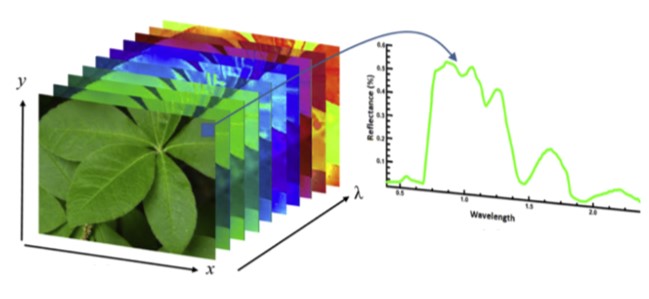
Hyperspectral imaging, an emerging technology at the crossroads of science and technology, is opening up exciting new perspectives in quality control and detection. This advanced method of image capture offers an extended spectral vision that transcends the limits of human vision, enabling innovative applications in fields ranging from agriculture to industry.
Deciphering an innovative technology
Unlike traditional imaging, which captures three spectral bands (red, green, blue), hyperspectral imaging divides light into a multitude (tens, hundreds, even thousands) of narrow (10nm), contiguous spectral bands covering the entire electromagnetic spectrum.
Each spectral band corresponds to a narrow ‘slice’ of the electromagnetic spectrum. The hyperspectral camera measures the light intensity in each of these slices for each pixel in the image, creating a hyperspectral ‘data cube’.
Hyperspectral data provides detailed information about the chemical composition, reflectance and other characteristics of objects in the scene. Each pixel in the hyperspectral image represents a unique spectral signature, which can be associated with a feature, substance or material.
This technology enables extremely detailed analysis of objects in an observed scene, revealing information invisible to the naked eye.
In other words, it offers a finer, better-documented view of the world, paving the way for diverse applications ranging from industrial quality control to the detection of specific substances in a wide range of fields.
quality control and detection: the hunt for defects and hidden substances
In the field of quality control, hyperspectral imaging is becoming a major asset. Manufacturers can now inspect products with unrivalled precision, identifying defects invisible to the naked eye.
For example, in food production, hyperspectral imaging is used to inspect food quality and ripeness, detect potential contaminants, assess the freshness of perishable products, estimate their nutritional composition and ensure compliance with food safety standards. In this way, it helps to boost consumer confidence in food products.
The pharmaceutical industry also uses this technology at various stages of the drug manufacturing and quality control process, helping to guarantee the quality, safety and efficacy of medicines throughout their life cycle. In particular, it is used to inspect pharmaceutical raw materials, analyse tablet composition, detect contaminants, monitor manufacturing stages and assess dissolution in the body.
Hyperspectral imaging also has crucial applications in industrial sectors, where it can detect tiny defects, variations in composition or other imperfections in manufactured products that might escape traditional visual inspection. This helps to ensure product reliability and compliance with quality standards.
Another area where hyperspectral imaging stands out is the detection of specific substances. Applications range from agriculture to medicine.
For example, in precision agriculture, it is used to monitor the health of crops. it enables the early detection of stress, disease, pests or nutritional and water deficiencies in plants, facilitating more precise crop management, optimising yields and reducing the use of fertilisers.
In medicine, hyperspectral imaging is being explored to detect diseases such as cancer at an early stage, to provide surgeons with real-time information during surgical procedures, and to study skin disorders in dermatology. Its adoption in the medical field opens the way to more accurate diagnoses, more targeted surgical interventions and a deeper understanding of biological processes. Although its use is still under development, it promises to bring significant improvements in various aspects of healthcare.
This innovative technology has applications in a multitude of other fields, including the environment, remote sensing, archaeology, aerospace, automotive and more. Its versatility makes it a powerful tool for tackling a wide range of issues.
the challenges and prospects of hyperspectral imaging: a promising horizon
Hyperspectral imaging offers significant advantages, but it must overcome certain challenges to maximise its potential. The high cost and massive data management requirements of a hyperspectral camera generally hinder its use in an industrial solution. However, i2S has developed an analysismethod that enables the most relevant wavelengths to be precisely determined in the feasibility phase to meet the specific needs of the application and to be limited to a less expensive multispectral system in the final product. this targeted approach makes it possible to take advantage of hyperspectral imaging while optimising resources and offering more affordable solutions to its customers.
